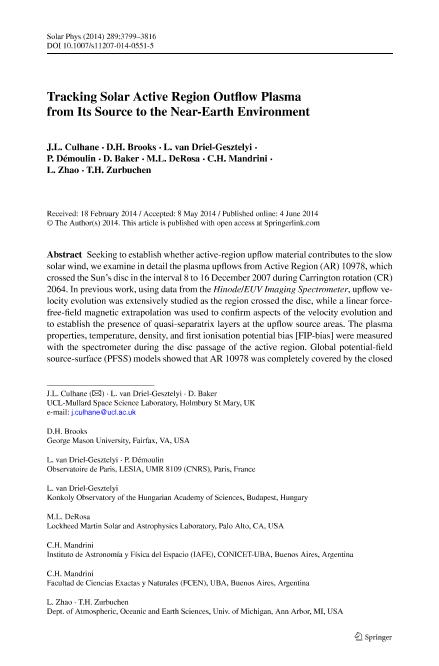Mostrar el registro sencillo del ítem
dc.contributor.author
Culhane, J. l.
dc.contributor.author
Brooks, D. H.
dc.contributor.author
van Driel Gesztelyi, Lidia

dc.contributor.author
Démoulin, Pascal

dc.contributor.author
Baker, D.
dc.contributor.author
DeRosa, M.l.
dc.contributor.author
Mandrini, Cristina Hemilse

dc.contributor.author
Zhao, L.
dc.contributor.author
Zurbuchen, T. H.
dc.date.available
2017-06-06T15:25:36Z
dc.date.issued
2014-10
dc.identifier.citation
Culhane, J. l.; Brooks, D. H.; van Driel Gesztelyi, Lidia; Démoulin, Pascal; Baker, D.; et al.; Tracking Solar Active Region Outflow Plasma from Its Source to the Near-Earth Environment; Springer; Solar Physics; 289; 10; 10-2014; 3799-3816
dc.identifier.issn
0038-0938
dc.identifier.uri
http://hdl.handle.net/11336/17567
dc.description.abstract
Seeking to establish whether active region upflow material contributes to the slow solar wind, we examine in detail the plasma upflows from Active Region (AR)10978, which crossed the Sun's disc in the interval 8 to 16 December, 2007 during Carrington rotation (CR)2064. In previous work, using data from the Hinode/EUV Imaging Spectrometer, upflow velocity evolution was extensively studied as the region crossed the disc while a linear force-free magnetic extrapolation was used to confirm aspects of the velocity evolution and to establish the presence of quasi-separatrix layers at the upflow source areas. The plasma properties, temperature, density and first ionisation potential bias (FIP-bias) were measured with the spectrometer during the disc passage of the active region. Global potential field source surface (PFSS) models showed that AR 10978 was completely covered by the closed field of a helmet streamer that is part of the streamer belt. Thus it is not clear how any of the upflowing AR-associated plasma could reach the source surface at 2.5 R(Sun)and contribute to the slow solar wind. However a detailed examination of solar-wind in-situ data obtained by the Advanced Composition Explorer (ACE) spacecraft at the L1 point shows that the increase in O^7+/O^6+, C^6+/C^5+ and Fe/O - a FIP-bias proxy - are present before the heliospheric current sheet crossing. These increases, along with an accompanying reduction in proton velocity and an increase in density are characteristic of both AR and slow-wind plasma. Finally we describe a two-step reconnection process by which some of the upflowing plasma from the AR could reach the heliosphere.
dc.format
application/pdf
dc.language.iso
eng
dc.publisher
Springer

dc.rights
info:eu-repo/semantics/openAccess
dc.rights.uri
https://creativecommons.org/licenses/by-nc-sa/2.5/ar/
dc.subject
Active Region Upflows
dc.subject
Magnetic Topology
dc.subject
Slow Solar Wind
dc.subject.classification
Astronomía

dc.subject.classification
Ciencias Físicas

dc.subject.classification
CIENCIAS NATURALES Y EXACTAS

dc.title
Tracking Solar Active Region Outflow Plasma from Its Source to the Near-Earth Environment
dc.type
info:eu-repo/semantics/article
dc.type
info:ar-repo/semantics/artículo
dc.type
info:eu-repo/semantics/publishedVersion
dc.date.updated
2017-06-01T16:45:28Z
dc.journal.volume
289
dc.journal.number
10
dc.journal.pagination
3799-3816
dc.journal.pais
Alemania

dc.journal.ciudad
Berlin
dc.description.fil
Fil: Culhane, J. l.. UCL-Mullard Space Science Laboratory; Reino Unido
dc.description.fil
Fil: Brooks, D. H.. George Mason University; Estados Unidos
dc.description.fil
Fil: van Driel Gesztelyi, Lidia. UCL-Mullard Space Science Laboratory; Reino Unido
dc.description.fil
Fil: Démoulin, Pascal. Centre National de la Recherche Scientifique. Observatoire de Paris; Francia
dc.description.fil
Fil: Baker, D.. UCL-Mullard Space Science Laboratory; Reino Unido
dc.description.fil
Fil: DeRosa, M.l.. Lockheed Martin Solar and Astrophysics Laboratory; Estados Unidos
dc.description.fil
Fil: Mandrini, Cristina Hemilse. Consejo Nacional de Investigaciónes Científicas y Técnicas. Oficina de Coordinación Administrativa Ciudad Universitaria. Instituto de Astronomía y Física del Espacio. - Universidad de Buenos Aires. Facultad de Ciencias Exactas y Naturales. Instituto de Astronomía y Física del Espacio; Argentina
dc.description.fil
Fil: Zhao, L.. University of Michigan; Estados Unidos
dc.description.fil
Fil: Zurbuchen, T. H.. University of Michigan; Estados Unidos
dc.journal.title
Solar Physics

dc.relation.alternativeid
info:eu-repo/semantics/altIdentifier/arxiv/https://arxiv.org/abs/1405.2949
dc.relation.alternativeid
info:eu-repo/semantics/altIdentifier/url/https://link.springer.com/article/10.1007/s11207-014-0551-5
dc.relation.alternativeid
info:eu-repo/semantics/altIdentifier/doi/http://dx.doi.org/10.1007/s11207-014-0551-5
Archivos asociados
